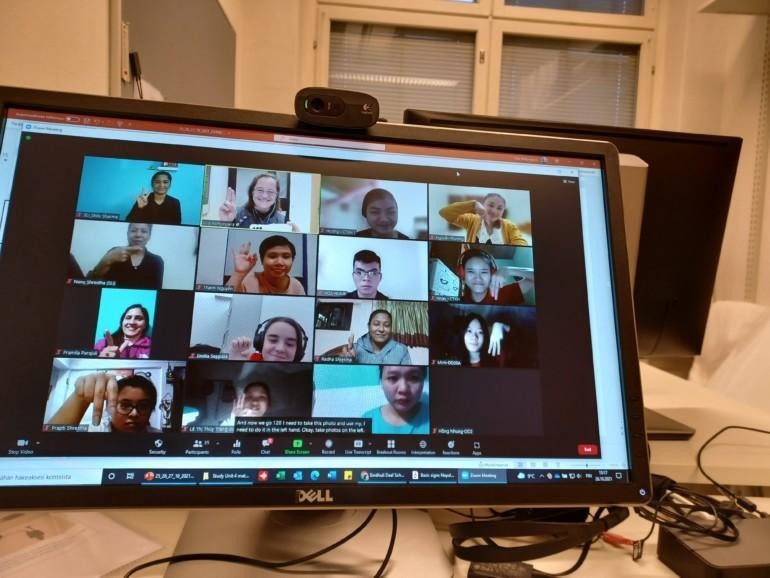Distance learning solutions and hybrid learning

The realisation of communication and hybrid learning in an international project requires the right tools. Hybrid learning refers to a model where some students attend class in-person, while others join the class online. What tools were used in the DVINE project – especially in distance learning during the Covid-19 pandemic?
The DVINE project (2019–2023) develops education in Nepal and Vietnam. Distance learning and the physical distance between the participants had a greater impact than expected on the curricula that were developed. Some groups were also hybrid learning groups, with some students in the classroom and some online.
Time zone differences posed challenges in scheduling lectures. The range of tools used in distance learning had to be suitable from many different perspectives.
Remote tools that support dialogue
Dialogue in different languages, with different concepts and with different educational and cultural backgrounds, challenged our interaction skills. The success of the dialogue requires that the participants have the skills and possibilities to ask, listen and encounter.
Different teaching styles, from authoritarian learning to student-centred learning, became important at different stages of the DVINE project.
Interpreting and variation in languages and skills were a huge challenge during meetings and training.
In the project, I participated in Study Unit 4, Communication and sign language. At an early planning stage, we realised that the choice of distance learning tools had a great impact if we wanted to enhance interaction, dialogue and learning, and do this sustainably.
Five perspectives for distance learning tools
Five (5) different perspectives emerged in the selection of distance learning tools and applications:
- The application needed to be available internationally, preferably as a free version. The login process had to be simple, and the program had to work even if the network connection was weak. Social media programs had to be available in the project countries.
- Easy to use. Teachers and students had a limited amount of time, so the program had to be easy to learn and logical to use without separate training.
- Programs with a fresh and contemporary visual look were functional. Good image quality, use of cameras, and good visibility were elements that increase interaction and encounter.
- Sustainable development. The information had to remain available, applicable and disseminated even after the project had ended.
- Information and materials needed to be edited, stored, co-developed, subtitled and translated.
Availability was the main factor. Moodle, Microsoft Office, Stream, Howspace, and other expensive online platforms were ruled out and replaced by the free Google Classroom learning platform. Google Jamboard also proved an easy-to-use program to increase interactivity.
It’s reliability even when connections were weak, ease of use, recording, and ability to use visual videos made Zoom the best video conferencing program from the outset.
Storing data sustainably is a challenge. Google Classroom does not allow open sharing of materials without logging in, so we solved this by using Blogger and YouTube.
The Blogger blog included material for teachers and links to a collection of tools for teachers. The use of the blog in the free program allowed teachers to access the material for further development.
Video and audio content production
YouTube and Prezi Video were selected as tools for sharing and storing videos. YouTube’s playlist feature facilitated the sharing of instructional videos made during the project. We made some of the videos with the students, so the materials were produced by teamwork.
Through Prezi Video, we shared a few instructional videos, but the challenge was that the free version did not allow the video to be uploaded to anything other than Prezi’s own system. The strengths of Prezi Videos were their accessibility, visuals and the ability to link directly to the Google Classroom.
In addition to the videos, we made podcasts, which we also published subtitled in vodcast format. Making vodcasts increased multidisciplinary reflection, peer learning, and collaboration with colleagues and students.
The potential of social media
More social media tools could have been used in the teaching, such as making materials for Instagram or TikTok using the PhotoVoice method, or sign banks in sign language. However, Instagram was not yet very popular in the project countries.
The social media channels Twitter and Facebook worked well in communicating about the project. In addition, Messenger, which operates within Facebook, served as a communication channel to Nepal and Vietnam in addition to email. It allowed quicker communication than emails.
New insights through pedagogical choices
Pedagogical dialogue at a distance can be enabled by discovery, experimentation and new insight. During the project, we also used videos to develop a new form of study for simulation pedagogy. The students watched the video from different stages of the simulated situation via YouTube and analysed it in different assignments in Google Classroom. The aim was to increase participants’ knowledge and understanding of, and sensitivity to, the perception of communication challenges in nursing and client work.
The dialogic pedagogy of change includes continuous, developmental and communicative interaction. Through this interaction, we gain a better understanding of the world, ourselves and each other. Sometimes none of the participants knows exactly where the dialogue is heading, and whether its outcome is successful. This was also the case during the DVINE project.
The diverse and complex dialogue that took place during the project has been a process in which uncertainty can be seen as a significant way to create something new in the field of pedagogy, and distance and hybrid learning.
Produced learning materials
In the project’s final stages, we collaborated in the creation of a brochure on Vietnamese Sign Language (VSL). The result was a brochure that partners could print or publish online for their students.
Other learning materials
Text: Ulla Niittyinperä
